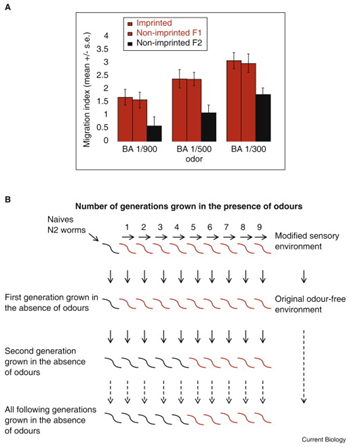Cross-posted from Reaction Norm…

![]() Here he is “late in life.” Everyone already thinks he’s wrong wrong WRONG. We know him now as the Wrongest Biologist Ever. When we say “Lamarckian” we mean the idea that acquired characteristics can be inherited. I can almost hear him crying from the grave, “I produced a lifetime of ideas on all kinds of stuff, yet ‘Lamarckian’ will always mean just that one thing.” No wonder he looks a little shifty and bitter. Well, most of his other stuff was wrong too, but it was like 1800 and he was trying to convince people that species evolved without divine intervention! Pardon him for not getting the details right.
Here he is “late in life.” Everyone already thinks he’s wrong wrong WRONG. We know him now as the Wrongest Biologist Ever. When we say “Lamarckian” we mean the idea that acquired characteristics can be inherited. I can almost hear him crying from the grave, “I produced a lifetime of ideas on all kinds of stuff, yet ‘Lamarckian’ will always mean just that one thing.” No wonder he looks a little shifty and bitter. Well, most of his other stuff was wrong too, but it was like 1800 and he was trying to convince people that species evolved without divine intervention! Pardon him for not getting the details right.
But he was wrong. Except when he was right. “Lamarckian” phenomena aren’t all that uncommon, especially in prokaryotes. Of course, he was still wrong because he didn’t know about any of the phenomena that he was right about—he was basing his ideas on types of evolution that simply aren’t “Lamarckian.” It’s fashionable these days to defend Lamarck, and it’s always been fashionable to dismiss things like genetic assimilation or the Baldwin Effect as “Lamarckian,” which they aren’t. Someday, perhaps someone will describe some epigenetic phenomenon in which an environmental variable specifically alters a locus in the germ line (Weissman stirs in his grave) such that the inheritors of that altered locus are better adapted to that environment. But no one is holding their breath.
But wait! What’s this in today’s issue of Current Biology?
Stable inheritance of an acquired behavior in Caenorhabditis elegans
Huh. First, it’s a single author paper, which is sometimes a crackpot alert. But Current Biology is respectable. And the author, Jean-Jacques Remy is from a respectable lab. And it’s a really simple paper with no mechanism, just getting the phenomenon itself out there. So here it is.
 C. elegans imprints on odors it experiences as young worm. If they are exposed to benzaldehyde as larvae, they show a greater level of attraction to benzaldehyde as adults. This involves a couple neurons. Now, Remy is claiming that if a worm is imprinted, its offspring (F1) show the same enhanced attraction to benzaldehyde, even though it’s never smelled it before. However, the grandkids (F2) do not show the imprinting effect.
C. elegans imprints on odors it experiences as young worm. If they are exposed to benzaldehyde as larvae, they show a greater level of attraction to benzaldehyde as adults. This involves a couple neurons. Now, Remy is claiming that if a worm is imprinted, its offspring (F1) show the same enhanced attraction to benzaldehyde, even though it’s never smelled it before. However, the grandkids (F2) do not show the imprinting effect.
If however you imprint multiple generations (more than 4), the behavioral switch becomes stable, and is inherited for multiple generations (at least up to 40 generations). The behavior is odor-specific and is also discrete—there is an “imprinted” state and a “naïve” state, with nothing in between, as you would expect if there was something being diluted over time.
Note, this is not genetic assimilation for two reasons: 1. There is no selection for the behavior, 2. This is all done in an isogenic strain—there is no genetic variation in the population.
That’s all there is to it—no experiments to get at mechanism. So we’re left with a sort of “ok, you need to convince me it’s real” kind of feeling. There is a lot they could be doing here, and probably are. For example, testing the requirement for chromatin modifying enzymes, or microarray analysis of imprinted and unimprinted lines. The fact that they published this as just the behavioral inheritance observation makes me think there is competition and Remy wants priority. Anyway, it will be exciting to see how this plays out.
Anyone see any obvious problems with the data (such as it is)?
Remy, J. (2010). Stable inheritance of an acquired behavior in Caenorhabditis elegans Current Biology, 20 (20) DOI: 10.1016/j.cub.2010.08.013

Comments are closed.